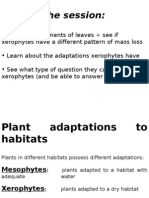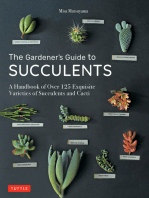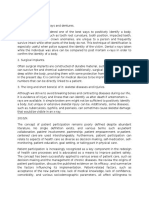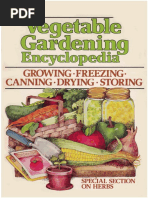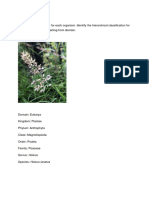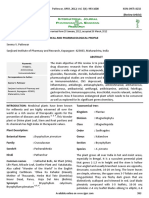Adaptation in Plants
Adaptation in Plants
Uploaded by
Abhisek SarkarCopyright:
Available Formats
Adaptation in Plants
Adaptation in Plants
Uploaded by
Abhisek SarkarOriginal Description:
Copyright
Available Formats
Share this document
Did you find this document useful?
Is this content inappropriate?
Copyright:
Available Formats
Adaptation in Plants
Adaptation in Plants
Uploaded by
Abhisek SarkarCopyright:
Available Formats
Adaptation in plants:
Xerophytes
These are plants that grow in places with scanty water such as deserts and sandy hills. The plant is
modified so that it can withstand prolonged periods of drought conditions without getting harmed.
The following parts of the plant undergo modification.
Root - Produce a long taproot that grows deep into the soil in search of water.E.g. Alhagi
Leaf- Undergo various types of modifications in order to reduce transpiration(loss of water
through the leaves), or even store water.
In Acacia and Prosopis the leaves are reduced in size.
In Calotropis the epidermis of the leaf is covered with fine hair.
In Nerium there is multiple epidermis and sunken stomata.
In Opuntia (prickly pear) and Euphorbia the leaves are reduced to spines.
Stem: In Opuntia the stem performs the function of storage of reserve water and so becomes
thick and fleshy. It also turns green because of the presence of chlorophyll as it performs
photosynthesis. The epidermis of the stem is covered with a waxy layer to prevent loss of
water.
Mesophytes
These are plants that grow under average conditions of temperature and moisture. This group of
plants is intermediate between Xerophytes and Hydrophytes. They show the following adaptations.
Root - The root system is well developed with the taproot in dicotyledons and fibrous roots in
monocotyledons.
Stem - The stem is solid and well branched.
Leaves - The leaves are green and well developed. They are provided with cuticle. The
leaves have stomata on the lower surface.
Example:
Mango, Maize, Tomato and Wheat
Hydrophytes
These are plants that grow in water or in very wet places. They may be floating, rooted and floating
or submerged. The following are the adaptations found in this group.
Root - The root system is poorly developed as in Eichhornia or absent as in Ceratophyllum
Stem - The stem may be reduced as in Lemna (Duckweed) or may be long, slender, flexible
and spongy as in Nelumbo (Lotus). The spongy nature is due to the large air spaces which
makes them buoyant.
Leaves - The leaves may be thin and finely dissected as in Hydrilla or ribbon-like as in
Vallisneria. In Nelumbo the leaves are large and flat with their upper surface coated with wax.
Stomata are found only on the upper surface in floating plants. They are absent in
submerged plants.
Why Transpiration is a Necessary Evil:
i. Transpiration has paramount importance as transpiration pull help in ascent of sap and
influence the rate of water absorption by plants.
j. Transpiration cause cooling thus controls the internal temperature of plant body.
k. It helps in gaseous exchange, besides the above importance transpiration cause.
l. Water deficit in plant resulting wilting permanent wilting or death of plants.
m. It causes shedding of leaves.
n. Unnecessary wastage of water from soil and plant body.
o. Structural adoptions required with expense of tissue in xerophyes.
Inspite of above diadvtages plant cannot avoid transpiration, for which curtis (1926) called
transpiration as a necessary evil.
You might also like
- JAMB Biology Questions and Answers 2023Document5 pagesJAMB Biology Questions and Answers 2023Samuel Bless100% (9)
- Hydrophyte and XerophyteDocument2 pagesHydrophyte and Xerophyteapi-309893409100% (1)
- 13.10 Limiting Water Loss in PlantsDocument17 pages13.10 Limiting Water Loss in PlantsgereseNo ratings yet
- Angiosperm Is The Most Successful Plant in The Exploitation of Many Terrestrial HabitatsDocument8 pagesAngiosperm Is The Most Successful Plant in The Exploitation of Many Terrestrial Habitatsaesha89100% (5)
- Xero HydrophytesDocument1 pageXero HydrophytesAnathiNo ratings yet
- PBL Plant AdaptationDocument55 pagesPBL Plant Adaptationcindy_lee_11No ratings yet
- PBOT111 Part2Document15 pagesPBOT111 Part2pleasehelpme498No ratings yet
- Adaptation of Plants To Their Habitats.: HydrophytesDocument4 pagesAdaptation of Plants To Their Habitats.: HydrophytesEric KisiluNo ratings yet
- F4 Lesson 4 Transport in PlantsDocument4 pagesF4 Lesson 4 Transport in Plantskith geniNo ratings yet
- Bio AssignmentDocument5 pagesBio AssignmentArun RajNo ratings yet
- Yoyo Plant BioDocument6 pagesYoyo Plant BioYOLANDA NYARADZO MUPITANo ratings yet
- Plant Behavioural Strategies For SurvivalDocument3 pagesPlant Behavioural Strategies For SurvivalNancyNguyen16No ratings yet
- Plant AdaptationsDocument12 pagesPlant AdaptationsHitesh PandeyNo ratings yet
- Hydrophytes & XerophytesDocument5 pagesHydrophytes & Xerophytesahmedabdelmottaleb26No ratings yet
- Transport in PlantsDocument24 pagesTransport in Plantsakaileerichardson08No ratings yet
- Xerophytes and HydrophytesDocument23 pagesXerophytes and HydrophytesTanyaradzwa MugutaNo ratings yet
- 7 Adaptations of Plants 2021Document16 pages7 Adaptations of Plants 2021seth82024No ratings yet
- Root Modifications Storage RootsDocument17 pagesRoot Modifications Storage Rootsmbg1110100% (1)
- Chapter 7.0Document7 pagesChapter 7.0ayris.mohdkNo ratings yet
- XerophytesDocument22 pagesXerophytesSuresh Kumar A PNo ratings yet
- AdaptationsDocument7 pagesAdaptationsBadejo AnthonyNo ratings yet
- Adaptations in Plants and Animals of Xerophytic Condition: Biology Investigatory ProjectDocument43 pagesAdaptations in Plants and Animals of Xerophytic Condition: Biology Investigatory ProjectSezzal KujurNo ratings yet
- XeroDocument3 pagesXeroanon_666490796No ratings yet
- Plants Adaptations NotesDocument14 pagesPlants Adaptations NotessmedificationNo ratings yet
- Transport in PlantsDocument17 pagesTransport in PlantsMichelle HlungwaniNo ratings yet
- Ecological Adaptations in Hydrophytes and XerophytesDocument9 pagesEcological Adaptations in Hydrophytes and XerophytesDulay, Shennah S.No ratings yet
- xerophytes research taskDocument2 pagesxerophytes research taskcc100No ratings yet
- 5-Morphology of Flowering PlantsDocument15 pages5-Morphology of Flowering PlantsVasant Kumar VarmaNo ratings yet
- PLANTDocument23 pagesPLANTAngelito HalmainNo ratings yet
- Leaves - Plant Biology: Leaf Arrangements and TypesDocument10 pagesLeaves - Plant Biology: Leaf Arrangements and TypesHarissudin MasrurNo ratings yet
- Diwey Perez Ikitan Jomer Jireh Pinalapal Jane Prudenciano Ruffa Prudenciano Marvin Carl Chico Tintin Pastor TagapuenDocument29 pagesDiwey Perez Ikitan Jomer Jireh Pinalapal Jane Prudenciano Ruffa Prudenciano Marvin Carl Chico Tintin Pastor TagapuenKristina PonceNo ratings yet
- Ecological Plant AdaptationDocument6 pagesEcological Plant AdaptationYamu HiadeenNo ratings yet
- Special LeavesDocument2 pagesSpecial LeavesSage83No ratings yet
- Ecological AdaptationsDocument75 pagesEcological AdaptationsNANCY DEBORAHNo ratings yet
- Plant Adaptations For Water Conservation by Masindi NtikanaDocument12 pagesPlant Adaptations For Water Conservation by Masindi NtikanaMasindi NtikanaNo ratings yet
- Chapter 7 Adaptation of Plants in Different HabitatsDocument24 pagesChapter 7 Adaptation of Plants in Different HabitatsMARLIANA IRYANI BINTI YAACOB KPM-GuruNo ratings yet
- Arity Desert PlantsDocument49 pagesArity Desert PlantsMart KarmNo ratings yet
- Adaptions of plantsDocument2 pagesAdaptions of plantsBRIANNA AVA GERALD MoeNo ratings yet
- Vascular PalntDocument33 pagesVascular Palntnuel0698No ratings yet
- Hydro Phy EtesDocument3 pagesHydro Phy Etespitumitu2003No ratings yet
- Plant Adaptations To The RainforestDocument5 pagesPlant Adaptations To The RainforestLaura NananNo ratings yet
- Excretion in Plants: - Plants Do Not Have Nitrogenous Waste Products in The Same Way As AnimalsDocument27 pagesExcretion in Plants: - Plants Do Not Have Nitrogenous Waste Products in The Same Way As Animalsmagicman20202000No ratings yet
- English DataDocument2 pagesEnglish DataAsim Hussain KhanNo ratings yet
- 8 1 Tttteachers Notes Awesome AdaptationsDocument4 pages8 1 Tttteachers Notes Awesome AdaptationsSaarah Sthellar MagnayeNo ratings yet
- DiscussionDocument1 pageDiscussionRenisha KathirvelooNo ratings yet
- Structural Modification of Root and StemDocument23 pagesStructural Modification of Root and Stemanupreetk1812No ratings yet
- Plant AdaptationsDocument20 pagesPlant Adaptationsnozel77No ratings yet
- XerophytesDocument21 pagesXerophytesapi-3805717100% (3)
- Add Notes Wk2Document3 pagesAdd Notes Wk2tatenda4201No ratings yet
- Specialized Roots: Aerating Roots of ADocument2 pagesSpecialized Roots: Aerating Roots of ASeleneblueNo ratings yet
- Leaf - WikipediaDocument168 pagesLeaf - WikipediaBashiir NuurNo ratings yet
- Landscape ArchitectureDocument21 pagesLandscape ArchitectureSujith KsNo ratings yet
- Xero PH YtesDocument21 pagesXero PH Ytesβινιτ οζαNo ratings yet
- Basic Plant Parts NotesDocument24 pagesBasic Plant Parts Notesnelly53adNo ratings yet
- Adaptive FeaturesDocument5 pagesAdaptive FeaturesAfifa AlamNo ratings yet
- Characteristics of Terrestrial PlantsDocument12 pagesCharacteristics of Terrestrial PlantsNelita Gumata Rontale100% (1)
- BS Anatomy Final Course: Anatomical Features of HydrophytesDocument25 pagesBS Anatomy Final Course: Anatomical Features of HydrophytesNadeem ShahzadNo ratings yet
- Gardener's Guide to Succulents: A Handbook of Over 125 Exquisite Varieties of Succulents and CactiFrom EverandGardener's Guide to Succulents: A Handbook of Over 125 Exquisite Varieties of Succulents and CactiRating: 4.5 out of 5 stars4.5/5 (3)
- The Natural Design of Trees: A Complete Manual to Unlock the Secrets of the Forest and the Fascinating Science of Tree Biology and EvolutionFrom EverandThe Natural Design of Trees: A Complete Manual to Unlock the Secrets of the Forest and the Fascinating Science of Tree Biology and EvolutionNo ratings yet
- Botany PracticalDocument1 pageBotany PracticalAbhisek SarkarNo ratings yet
- Note On House Rent AllowanceDocument5 pagesNote On House Rent AllowanceAbhisek SarkarNo ratings yet
- Java AwtDocument2 pagesJava AwtAbhisek Sarkar100% (1)
- Production Management: SamplingDocument4 pagesProduction Management: SamplingAbhisek Sarkar0% (1)
- What Is A Neural Network?Document3 pagesWhat Is A Neural Network?Abhisek SarkarNo ratings yet
- Abiotic/Physical Component: Biology Chemical Physical Environment Evolution GeodiversityDocument3 pagesAbiotic/Physical Component: Biology Chemical Physical Environment Evolution GeodiversityAbhisek SarkarNo ratings yet
- 4P's of SPMDocument1 page4P's of SPMAbhisek SarkarNo ratings yet
- Hardware & Software RequirementDocument1 pageHardware & Software RequirementAbhisek SarkarNo ratings yet
- Wage and SalaryDocument2 pagesWage and SalaryAbhisek Sarkar100% (1)
- Bipolar 8-Zero Substitution (B8ZS) : Encoding T1 VoltageDocument1 pageBipolar 8-Zero Substitution (B8ZS) : Encoding T1 VoltageAbhisek SarkarNo ratings yet
- Collaboration, Patient Involvement, Partnership, Patient Empowerment, or Patient-Centered Care Are Used Interchangeably. Furthermore, Patient Participation CanDocument2 pagesCollaboration, Patient Involvement, Partnership, Patient Empowerment, or Patient-Centered Care Are Used Interchangeably. Furthermore, Patient Participation CanAbhisek SarkarNo ratings yet
- 1) Comparison Between MIS and DSSDocument3 pages1) Comparison Between MIS and DSSAbhisek SarkarNo ratings yet
- Finite State TransducersDocument4 pagesFinite State TransducersAbhisek SarkarNo ratings yet
- Types/Levels of Cache MemoryDocument1 pageTypes/Levels of Cache MemoryAbhisek SarkarNo ratings yet
- Interactive Computer Graphics and Passive Computer GraphicsDocument1 pageInteractive Computer Graphics and Passive Computer GraphicsAbhisek SarkarNo ratings yet
- Eye Outpatient Satisfaction Survey (For General Information)Document3 pagesEye Outpatient Satisfaction Survey (For General Information)Abhisek SarkarNo ratings yet
- Hierarchical File StructureDocument2 pagesHierarchical File StructureAbhisek SarkarNo ratings yet
- The Fetch-Decode-Execute CycleDocument3 pagesThe Fetch-Decode-Execute CycleAbhisek SarkarNo ratings yet
- Sad IgnouDocument4 pagesSad IgnouAbhisek SarkarNo ratings yet
- Mothers Day CelebrationDocument1 pageMothers Day CelebrationAbhisek Sarkar100% (1)
- Fertilizer GuideDocument2 pagesFertilizer GuideGregory BakasNo ratings yet
- Drawings Paper 6.Document14 pagesDrawings Paper 6.menaabdelhady.412No ratings yet
- Action Plan EPP and Gulayan Sa PaaralanDocument2 pagesAction Plan EPP and Gulayan Sa PaaralanMarilyn Bido100% (2)
- 4.2 Transport of Water and Mineral SaltsDocument63 pages4.2 Transport of Water and Mineral Saltswickedbiology101No ratings yet
- Ncert Solutions Mar3 For Cbse Class 6 Science Chapter 9Document2 pagesNcert Solutions Mar3 For Cbse Class 6 Science Chapter 9Sunita MukherjeeNo ratings yet
- How A Soybean Plant Develops (1985)Document24 pagesHow A Soybean Plant Develops (1985)José Inés Bazán MotaNo ratings yet
- The Drift Newsletter For Tatworth & Forton Edition 073Document8 pagesThe Drift Newsletter For Tatworth & Forton Edition 073russ_wardell6953No ratings yet
- Activity 7 Angiosperm Plant BodyDocument13 pagesActivity 7 Angiosperm Plant BodyHerlyn SabulaanNo ratings yet
- Vegetable Gardening Encyclopedia PDFDocument261 pagesVegetable Gardening Encyclopedia PDFMapycha100% (7)
- Lesson 3 - Plant ReproductionDocument19 pagesLesson 3 - Plant Reproductionkashbxby.jjNo ratings yet
- Biology Assignment Sb025 DraftDocument14 pagesBiology Assignment Sb025 DraftKarenjit KaurNo ratings yet
- SSRN Id3582221Document9 pagesSSRN Id3582221Alexandra MojadoNo ratings yet
- Walioitwa Kazini 28.10.2024 (1)Document4 pagesWalioitwa Kazini 28.10.2024 (1)petropambano07No ratings yet
- Basic Pest & Disease Control For OrchidsDocument4 pagesBasic Pest & Disease Control For OrchidsAnonymous HXLczq3No ratings yet
- Dmbal PublicationDocument13 pagesDmbal PublicationArarsa LetaNo ratings yet
- Project ProposalDocument2 pagesProject ProposalMark Alvin EspirituNo ratings yet
- Strawberry Fertilisation PDFDocument2 pagesStrawberry Fertilisation PDFRoman PalanciucNo ratings yet
- KalanchoeDocument1 pageKalanchoeAnonymous iOYpj92No ratings yet
- Quality Protein Maize Production and Post Harvest Handling Handbook For East and Central AfricaDocument68 pagesQuality Protein Maize Production and Post Harvest Handling Handbook For East and Central AfricasedianpoNo ratings yet
- 31 Plant Hormones-SDocument6 pages31 Plant Hormones-SLeo Ding0% (1)
- Kew Sheet: InformationDocument2 pagesKew Sheet: InformationAndrew TanNo ratings yet
- Agri Asexual Propagation FinalDocument13 pagesAgri Asexual Propagation FinalPreciousAnneAnchetaMabazzaNo ratings yet
- The History of Roses: ReproductionDocument9 pagesThe History of Roses: ReproductionPatricia Anne SabladNo ratings yet
- World Fertilizer Use Manual Cashew (Anacardium Occidentale L.)Document3 pagesWorld Fertilizer Use Manual Cashew (Anacardium Occidentale L.)Amanda ValeNo ratings yet
- Landscape Architecture PortfolioDocument25 pagesLandscape Architecture PortfolioAnna PauletteNo ratings yet
- Symbiotic RelationshipsDocument2 pagesSymbiotic RelationshipsBianca Brocco100% (1)
- Gen Botany 1 28Document8 pagesGen Botany 1 28Ayako HayashidaNo ratings yet
- Part - I (MCQ) (Compulsory)Document4 pagesPart - I (MCQ) (Compulsory)Tehzeeb ZubairiNo ratings yet
- Identification of Unknown Plant SpecimensDocument29 pagesIdentification of Unknown Plant SpecimensArt Julius D. HallazgoNo ratings yet
















































